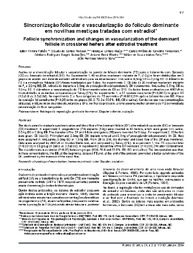Sincronização folicular e vascularização do folículo dominante em novilhas mestiças tratadas com estradiol.
Sincronização folicular e vascularização do folículo dominante em novilhas mestiças tratadas com estradiol.
Author(s): VIANA, J. H. M.
Summary: RESUMO - Avaliou-se a sincronização folicular e vascularização na parede do folículo dominante (FD) após o tratamento com Cipionato (CE) ou Benzoato de estradiol (BE). No Experimento 1, 45 novilhas receberam implante de P4 (1,0g) e foram distribuídas em 3 grupos de acordo com éster de estradiol administrado pela via intramuscular: 1mL salina; 0,5mg CE ou 2,0mg BE. O diâmetro do FD e a emergência folicular (EF) foram monitorados por 5 dias. No experimento 2, D0 (dia 0): 30 novilhas receberam implante de P4 e 2,0mg BE; D8, retirada do implante e 0,5mg de prostaglandina (cloprostenol); D9: tratamentos: 1mL salina; 0,5mg CE ou 1,0mg BE. O diâmetro e a vascularização do FD foram monitorados do D8 ao D10. Os dados foram analisados por ANOVA ou Kruskal-Wallis, e as médias comparadas por Tukey (5%). No experimento 1, a EF ocorreu mais tarde (P<0,0013) no grupo BE (4,3±0,8 vs. 3,5±0,8d). No experimento 2, o fluxo sanguíneo do FD aumentou (P<0,001) 24h após o tratamento com BE. A taxa de ovulação foi semelhante (P>0,05) entre os grupos (80,0, 70,0 e 55,5%, BE, CE e salina). Conclui-se que nas concentrações utilizadas, o BE, no início do protocolo, retardou a EF e, no final do protocolo, promoveu uma melhor sincronia do FD demonstrada pela elevação do fluxo sanguíneo. ABSTRACT - The study aimed to evaluate synchronization and blood flow of the dominant follicle (DF) after estradiol cypionate (EC) or benzoate (EB) treatment. In experiment 1, progesterone (P4) implants (1.0g) were inserted in 45 heifers, which were given 1mL saline, 0.5mg EC or 2.0mg EB. The diameter of the DF and follicle emergence (FE) were recorded for 5 days. For experiment 2, 30 heifers were given: D0 (day 0): P4 implant and 2.0mg EB; D8: implant removal and 0.5mg of prostaglandin (cloprostenol). On D9, they were assigned in 1mL saline, 0.5mg EC or 1.0mg EB. From D8 to D10, the diameter and blood flow of the DF was monitored. Data were analyzed by ANOVA or Kruskal-Wallis test, and compared by Tukey (5%). In experiment 1, the FE occurred later (P<0.0013) in EB group (4.3±0.8 vs. 3.5±0.8d). In experiment 2, blood flow of the DF increased (P<0.001) 24h after EB treatment. The ovulation rate was similar (P>0.05) between groups (80.0, 70.0 and 55.5%, EB, EC and saline). The interpretation was that, in these concentrations, the EB, at the beginning, delayed FE and, at the end of the protocol, promoted a better synchrony of the DF, confirmed by the increase of the blood flow.
Publication year: 2014
Types of publication: Journal article
Unit: Embrapa Dairy Cattle
Keywords: Doppler colorido, Emergência folicular, IATF, Ovulação, TETF
Observation
Some of Embrapa's publications are published as ePub files. To read them, use or download one of the following free software options to your computer or mobile device. Android: Google Play Books; IOS: iBooks; Windows and Linux: Calibre.
Access other publications
Access the Agricultural Research Database (BDPA) to consult Embrapa's full library collection and records.
Visit Embrapa Bookstore to purchase books and other publications sold by Embrapa.

